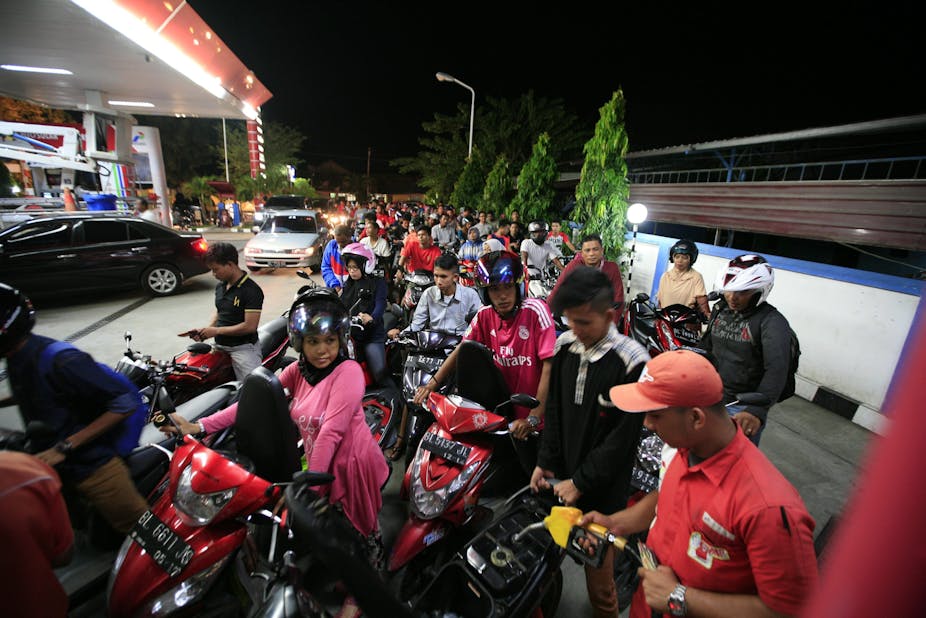Indonesia’s move to cut fuel subsidies, raising the prices of petrol and diesel by more than 30%, could be a game-changer for Indonesia’s economy.
The subsidies, which have kept fuel prices in Indonesia among the cheapest in the region, have been expensive, wasteful and ill-targeted. The cut could save Indonesia between US$8 billion and $10 billion in 2015.
If spent wisely, southeast Asia’s largest economy might be able to do away with its current account deficit.
Stopping wasteful and unaffordable spending
Indonesian president Joko Widodo announced the fuel price increase last week. He has been sending a clear message to the Indonesian public for months since his presidential campaign early this year. He wanted to transfer wasteful expenditure to financing productive sectors.
The fuel subsidy will cost Indonesia $20 billion this year, which is one-fifth of the country’s national budget. The high cost of fuel subsidies leaves little room for the government to finance infrastructure and welfare programs. It also contributes to Indonesia’s current account deficit as Indonesia is a net oil importer. Almost 75% of Indonesia’s imports are raw materials, with oil and gas making up to almost half.
In the third quarter of 2014, the current account deficit stood at $6.8 billion. Compared to previous quarter of $8.6 billion, this is an improvement. It is also better from the same period last year. However, the deficit is still big at around 3.07% of GDP.
Indonesia’s most basic economic problem lies in the lack of production. Neglect in the past 10 years in building roads, ports and bridges, as well as the power plants has caused stagnation the production of goods.
Important sectors that create jobs such as agriculture and manufacturing have weakened as well. Sectors that have grown rapidly are service, telecommunication and the financial industries, areas that create fewer jobs.
Dependence on “hot money”
To cover a current account deficit policymakers sometimes encourage short term investments, which makes the country dependent on “hot money”.
For example, in the third quarter of 2014, despite a deficit in the current account, Indonesia’s balance of payments was $6.4 billion in surplus. This shows that Indonesia is dependant on its $13.6 billion capital account, mostly consisting of short-term investments. Any shocks in the global financial market will pose a threat to the country’s balance of payments.
That was why Indonesia’s Central Bank increased their benchmark rate by 25 points to 7.75% one day after the fuel price hike. It is very possible that the Central Bank considered the country’s dependence to short term capital. Once the capital flows out of the country, it would cause a sharp depreciation on the Indonesian rupiah and a correction in its financial markets.
Investing on productive sectors
To move away from Indonesia’s dependence on “hot money”, Jokowi wants to develop Indonesia’s maritime sector.
He has been promoting his strategy to the Indonesian public and foreign investors to develop a maritime-based economy. Diverting savings from subsidy cuts to finance infrastructure projects that support his maritime vision could improve connectivity between islands and other countries. Domestic and international trade of goods can move faster.
According to World Bank’s 2014 Logistic Performance Index, Indonesia ranks 53 out of 160 countries. Australia ranks 16. Other Southeast Asian countries are also performing better than Indonesia. Singapore holds the fifth position, Malaysia 25, Thailand 35 and Vietnam 48.
China, Indonesia’s biggest trading partner, ranks 28. Thailand and Malaysia are among the top ten best performers among middle-income countries. In terms of logistics, Indonesia as Southeast Asia’s largest economy is way behind its regional partners.
In international shipping, Indonesia ranked 74, far from Vietnam at 42, Thailand at 39 and Malaysia at ten. The system to ship goods overseas is one of the main concerns. It takes three days to complete paperwork for exports. ASEAN countries average between one and two days.
Indonesia has made some progress but still has a lot of catching up to do. The time taken to unload cargo has been reduced from seven to 5.7 days. The government should realise the target to reduce this to four days.
Indonesia is also building an international port in North Jakarta. The first stage of the New Tanjung Priok port, worth Rp 25 trillion (around US$2 billion), is scheduled to be completed by 2018. Once completed the port will increase its capacity to six million containers per year.
A bitter pill to swallow
Cutting fuel subsidies is a bitter pill to swallow. The fuel price hike will increase the financial burden on Indonesia’s lower and middle class. Politically, it can cause problems with the parliament, currently dominated by the opposition.
The good thing is, Jokowi seems willing to back unpopular policies. He personally announced the fuel price hike, the first time for an Indonesian president has done so.
If Jokowi continues to adopt sound economic policies, slowly but surely Indonesia will improve its current account.

